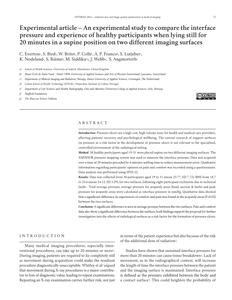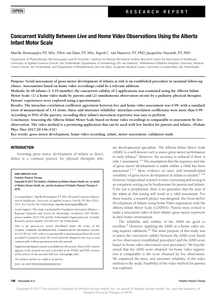Introduction: Pressure ulcers are a high cost, high volume issue for health and medical care providers, affecting patients’ recovery and psychological wellbeing. The current research of support surfaces on pressure as a risk factor in the development of pressure ulcers is not relevant to the specialised, controlled environment of the radiological setting. Method: 38 healthy participants aged 19-51 were placed supine on two different imaging surfaces. The XSENSOR pressure mapping system was used to measure the interface pressure. Data was acquired over a time of 20 minutes preceded by 6 minutes settling time to reduce measurement error. Qualitative information regarding participants’ opinion on pain and comfort was recorded using a questionnaire. Data analysis was performed using SPSS 22. Results: Data was collected from 30 participants aged 19 to 51 (mean 25.77, SD 7.72), BMI from 18.7 to 33.6 (mean 24.12, SD 3.29), for two surfaces, following eight participant exclusions due to technical faults. Total average pressure, average pressure for jeopardy areas (head, sacrum & heels) and peak pressure for jeopardy areas were calculated as interface pressure in mmHg. Qualitative data showed that a significant difference in experiences of comfort and pain was found in the jeopardy areas (P<0.05) between the two surfaces. Conclusion: A significant difference is seen in average pressure between the two surfaces. Pain and comfort data also show a significant difference between the surfaces, both findings support the proposal for further investigation into the effects of radiological surfaces as a risk factor for the formation of pressure ulcers.
DOCUMENT

To date, it is unknown whether waist circumference can be measured validly and reliably when a subject is in a supine position. This issue is relevant when international standards for healthy participants are applied to persons with severe intellectual, sensory, and motor disabilities. Thus, the aims of our study were (1) to determine the validity of waist circumference measurements obtained in a supine position, (2) to formulate an equation that predicts standing waist circumference from measurements obtained in a supine position, and (3) to determine the reliability of measuring waist circumference in persons with severe intellectual, sensory, and motor disabilities. First, we performed a validity study in 160 healthy participants, in which we compared waist circumference obtained in standing and supine positions. We also conducted a test-retest study in 43 participants with severe intellectual, sensory, and motor disabilities, in which we measured the waist circumference with participants in the supine position. Validity was assessed with paired t-test and Wilcoxon signed rank test. A prediction equation was estimated with multiple regression analysis. Reliability was assessed by Wilcoxon signed rank test, limits of agreement (LOA), and intraclass correlation coefficients (ICC). Paired t-test and Wilcoxon signed rank test revealed significant differences between standing and supine waist circumference measurements. We formulated an equation to predict waist circumference (R(2)=0.964, p<0.001). There were no significant differences between test and retest waist circumference values in disabled participants (p=0.208; Wilcoxon signed rank test). The LOA was 6.36 cm, indicating a considerable natural variation at the individual level. ICC was .98 (p<0.001). We found that the validity of supine waist circumference is biased towards higher values (1.5 cm) of standing waist circumference. However, standing waist circumference can be predicted from supine measurements using a simple prediction equation. This equation allows the comparison of supine measurements of disabled persons with the international standards. Supine waist circumference can be reliably measured in participants with severe intellectual, sensory, and motor disabilities.
DOCUMENT
UNLABELLED: Reaching movements are initiated by activity of the prime mover, i.e. the first activated arm muscle. We aimed to investigate the relationship between prime mover activity and kinematics of reaching in typically developing (TD) infants in supine and sitting position. Fourteen infants were assessed at 4 and 6 months during reaching in supine and supported sitting. Kinematics and EMG-activity of deltoid, pectoralis major, biceps (BB) and triceps brachii were recorded. Kinematic analysis focused on number of movement units (MUs) and transport MU (MU with longest duration). Prime mover use was variable, but at 6 months a dominance of BB emerged in both testing conditions. Kinematics were also variable, but with increasing age the number of MU decreased and the relative proportion of the transport MU increased. BB as prime mover at 6 months was related to a larger transport MU.CONCLUSION: Between 4 and 6 months BB prime mover dominance emerges which is related to relatively efficient reaching characteristics.
DOCUMENT
Dit artikel geeft inzicht in het fenomeen 'verzuring' van spieren door inspanning.
DOCUMENT

This thesis focuses on topics such as preterm birth, variation in gross motor development, factors that influence (premature) infant gross motor development, and parental beliefs and practices. By gaining insight into these topics, this thesis aims to contribute to clinical decision-making of paediatric physiotherapists together with parents, and with that shape early intervention.
DOCUMENT

BACKGROUND: Hospital stays are associated with high levels of sedentary behavior and physical inactivity. To objectively investigate physical behavior of hospitalized patients, these is a need for valid measurement instruments. The aim of this study was to assess the criterion validity of three accelerometers to measure lying, sitting, standing and walking. METHODS: This cross-sectional study was performed in a university hospital. Participants carried out several mobility tasks according to a structured protocol while wearing three accelerometers (ActiGraph GT9X Link, Activ8 Professional and Dynaport MoveMonitor). The participants were guided through the protocol by a test leader and were recorded on video to serve as reference. Sensitivity, specificity, positive predictive values (PPV) and negative predictive values (NPV) were determined for the categories lying, sitting, standing and walking. RESULTS: In total 12 subjects were included with a mean age of 49.5 (SD 21.5) years and a mean body mass index of 23.8 kg/m2 (SD 2.4). The ActiGraph GT9X Link showed an excellent sensitivity (90%) and PPV (98%) for walking, but a poor sensitivity for sitting and standing (57% and 53%), and a poor PPV (43%) for sitting. The Activ8 Professional showed an excellent sensitivity for sitting and walking (95% and 93%), excellent PPV (98%) for walking, but no sensitivity (0%) and PPV (0%) for lying. The Dynaport MoveMonitor showed an excellent sensitivity for sitting (94%), excellent PPV for lying and walking (100% and 99%), but a poor sensitivity (13%) and PPV (19%) for standing. CONCLUSIONS: The validity outcomes for the categories lying, sitting, standing and walking vary between the investigated accelerometers. All three accelerometers scored good to excellent in identifying walking. None of the accelerometers were able to identify all categories validly.
DOCUMENT

The purpose of this study was a serial assessment of gross motor development of infants at risk is an established procedure in neonatal follow-up clinics. Assessments based on home video recordings could be a relevant addition. In 48 infants (1.5-19 months), the concurrent validity of 2 applications was examined using the Alberta Infant Motor Scale: (1) a home video made by parents and (2) simultaneous observation on-site by a pediatric physical therapist. Parents’ experiences were explored using a questionnaire.
DOCUMENT

Heart-rate changes after transition from a supine to a standing posture were measured in 12 hypertensive and 12 normotensive primigravid women, in their last trimester of gestation. The subjects beat-to-beat heart-rate (HR) changes were recorded on both an ordinary cardiotocograph and on magnetic tape. The hypertensive patient group (1) reached an HR-maximum after standing up in a significantly shorter period of time and (2) had a significantly lower HR during 1 min erect posture. A population threatened by pregnancy-induced hypertension might be detected by using the non-invasive method of recording the maternal beat-to-beat heart-rate changes after transition to the standing posture, even before the onset of hypertension
DOCUMENT
Of all patients in a hospital environment, trauma patients may be particularly at risk for developing (device-related) pressure ulcers (PUs), because of their traumatic injuries, immobility, and exposure to immobilizing and medical devices. Studies on device-related PUs are scarce. With this study, the incidence and characteristics of PUs and the proportion of PUs that are related to devices in adult trauma patients with suspected spinal injury were described. From January–December 2013, 254 trauma patients were visited every 2 days for skin assessment. The overall incidence of PUs was 28⋅3% (n = 72/254 patients). The incidence of device-related PUs was 20⋅1% (n = 51), and 13% (n = 33) developed solely device-related PUs. We observed 145 PUs in total of which 60⋅7% were related to devices (88/145). Device-related PUs were detected 16 different locations on the front and back of the body. These results show that the incidence of PUs and the proportion of device-related PUs is very high in trauma patients
DOCUMENT

NeuroDevelopmental Treatment (NDT) is the most used rehabilitation approach in the treatment of patients with stroke in the Western world today, despite the lack of evidence for its efficacy. The aim of this study was to conduct an intervention check and measure the nurses' competence, in positioning stroke patients according to the NDT approach. The sample consisted of 144 nurses in six neurological wards who were observed while positioning stroke patients according to the NDT approach. The nurses' combined mean competence scores within the wards was 195 (70%) of 280 (100%) possible, and for each ward the mean score varied between 181 (65%) and 206 (74%). This study indicates that nurses working in hospitals where the NDT approach has been implemented have the knowledge and skills to provide NDT nursing.
DOCUMENT
